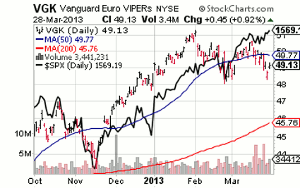Savvy traders can use ETFs to seek profits from the European crisis, says John Nyaradi of Wall Street Sector Selector.
The unity of the so-called European Union was tested this week when the Cyprus bank crisis reached a boiling point. Although default was averted, the situation in Europe and the European crisis are far from being “fixed” and this presents both problems and opportunities for investors going forward.
The biggest problem facing the Eurozone right now stems from the fact that approximately ten years ago, many its member nations began selling the rights to receive their revenue, which would be collected in the future. This tactic was employed as an end-run around the EU’s Maastricht Treaty, which placed limits on the debt levels for the member nations. This opened the door to the use of “off balance sheet accounting” and the magic of derivatives to obfuscate the true extent of an individual nation’s debt level.
Over time, nations such as Italy, Spain, and Greece ran up extraordinarily high sovereign debt levels from bailing out their banks, which led to the European crisis we are currently experiencing. To offset the European crisis, ECB president Mario Draghi initiated the Outright Monetary Transactions (OMT) program, whereby the ECB could make sovereign bond purchases. The purpose of the OMT program is to reduce the yields on those bonds to help the issuing countries avoid default. Nevertheless, participation in the OMT program requires compliance with certain conditions, including adherence to government spending—or austerity—guidelines. This is what is meant by the term “conditionality.”
Now “austerity” is being challenged as the ongoing political turmoil in Italy could ultimately force the question of whether the ECB will cut Italy from OMT as it threatened to cut Cyprus from the Emergency Liquidity Assistance (ELA) program.
Cyprus is a small economy and presented a unique situation, however, the European crisis stretches far beyond Cyprus as Italy has the third-largest amount of outstanding government debt in the world. Italy has issued more sovereign debt than Britain—an amount just over $2 trillion American dollars. The country with the most exposure to Italian debt is France, holding an amount in excess of 50 billion American dollars. France has a very fragile economy right now, having experienced 0.30% economic contraction during the fourth quarter of 2012. Germany is the second-largest holder of Italian debt, with over 40 billion American dollars’ worth of Italian bonds. Italy has the third-largest economy in the Eurozone.
Of particular concern at this crucial juncture is the fact that Italy’s center-left leader, Pier Luigi Bersani—who received the most votes in the country’s inconclusive February election—has been unable to form a coalition government. Although Bersani adjusted his position to embrace the Five-Star Movement’s rejection of the ECB austerity mandate, Five-Star leaders stubbornly refuse to support a leader from the center-left or the center-right.
NEXT PAGE: A Troubling Divergence
|pagebreak|Meanwhile, Enrico Giovannini of Istat (Italy’s statistics office) informed the nation’s parliament last Thursday that the nation’s recession is worse than reported last week. Last week’s forecast of 1.3% economic contraction during 2013 (compared with the previous forecast of 0.2 percent contraction) is now considered too optimistic.
Forecasts also indicate that the Eurozone will remain in recession for the foreseeable future, which will extend the European crisis. The International Monetary Fund recently projected that the Eurozone GDP would contract by 0.2% during 2013. American investors remain concerned about the European crisis and recession because the Eurozone provides the S&P 500 with 41% of its revenues.
Furthermore, fundamentals in Europe don’t point to a strong recovery as the recent Markit Economics PMI report showed March’s reading falling to 46.5 from February’s 47.9.
The chart below depicts a technical situation, which should also be of particular concern to American investors.

Chart courtesy of StockCharts.com
Click to Enlarge
In this chart, we can see the correlation between the Vanguard MSCI Europe ETF (VGK) and the S&P 500 Index (SPY). The two major indexes generally move in tightly correlated fashion but now we can see a divergence setting up between the two as the S&P 500 Index (SPY). continues to rise while the major European indexes are in decline.
Divergences like these are typically resolved and so either Europe has to improve or the S&P 500 has to decline to resolve this current situation.
Investors may want to adjust their trading strategies as a result of the unfolding events in Europe. Hedging positions with put options is a useful alternative to relying on stop orders to limit losses. There are also a number of ETFs, which deserve consideration should the situation in Europe continue to deteriorate. Here are some examples:
ProShares UltraShort Euro ETF (EUO) – This ETF is designed to obtain daily results that match twice the inverse (-2x) of the daily performance of the US dollar price of the euro and so should rise if the Eurodollar remains under pressure.
PowerShares Bullish Dollar Index Fund (UUP) – This ETF tracks the performance of the US Dollar Index and could continue to see gains if the flight to quality intensifies.
iShares 7-10 Year Treasury Bond ETF (TLT) – This ETF tracks the performance of the Barclays US 7-10 Year Treasury Bond Index and recent gains have been generated over concern for Europe and the global banking system.
By John Nyaradi, Publisher, Wall Street Sector Selector





















